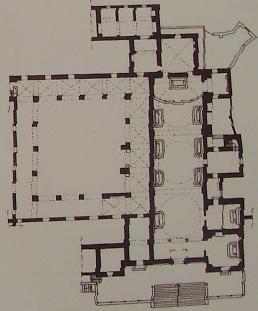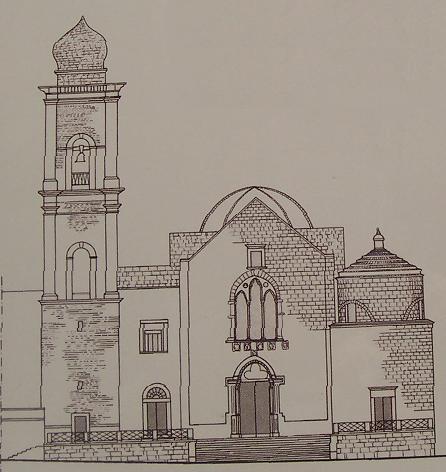Chiesa di S. Francesco
Tradition has it that the construction of this church testifies to St. Francis of Assisi's stay in Bitonto in 1222.

 The name "della scarpa" refers to the religious order that settled in this convent and not to the spot where this church was built, i.e. the spur, slope or escarp of the ancient city fortification. The building of the church and convent began at the end of the 13th century and lasted several decades under the supervision of Sergio Bove and on commission of Carlo d'Angio. The church was consecrated by Bishop Leucio at the beginning of the 14th century This austere and solemn building is built an a wide flight of stairs that makes it stand out even more. All that's left of its original structure are its facade and choir.
The name "della scarpa" refers to the religious order that settled in this convent and not to the spot where this church was built, i.e. the spur, slope or escarp of the ancient city fortification. The building of the church and convent began at the end of the 13th century and lasted several decades under the supervision of Sergio Bove and on commission of Carlo d'Angio. The church was consecrated by Bishop Leucio at the beginning of the 14th century This austere and solemn building is built an a wide flight of stairs that makes it stand out even more. All that's left of its original structure are its facade and choir.
 The facade has a simple hut shape and is embellished with a rich portal with jambs and fluted cornices and with a double archivolt decorated with leaves and pine-cones: the first arch of the archivolt rests on pilaster strips, the second one on delicate small columns with capitals. At the portal level, a superb three-light window with a great elliptic pointed arch is located. The ox is a recurrent image in the decorations: symbol of the Bove family.
The facade has a simple hut shape and is embellished with a rich portal with jambs and fluted cornices and with a double archivolt decorated with leaves and pine-cones: the first arch of the archivolt rests on pilaster strips, the second one on delicate small columns with capitals. At the portal level, a superb three-light window with a great elliptic pointed arch is located. The ox is a recurrent image in the decorations: symbol of the Bove family.
 The outside of the church features, on one side of the facade, a big 16th century chapel characterized by a cube-shaped structure with a high lantern above it and a cupola having the form of a truncated cone; on the other side of the facade there is a three-storey bell tower with a pyramidal bulb cupola, dating 1600.
The outside of the church features, on one side of the facade, a big 16th century chapel characterized by a cube-shaped structure with a high lantern above it and a cupola having the form of a truncated cone; on the other side of the facade there is a three-storey bell tower with a pyramidal bulb cupola, dating 1600.
 Inside the church, a spacious rectangular hall shelters precious works of art such as the 16th century altar with a mischio marble Communion table in the first big chapel on the left, a fine canvas by Gaspar Hovic (Virgin with Saints), the magnificent 14th century fresco of St Francis of Assisi and the 14th century fresco of the Virgin with Child in a Byzantyne style. Other works of art worth of notice inside the church are: a canvas of St. Joseph of Copertino by Carlo Rosa, the valuable 17th century wooden statue of Magdalene, the Dead Christ and the 17th century wooden statue of the Immaculate Virgin.
Inside the church, a spacious rectangular hall shelters precious works of art such as the 16th century altar with a mischio marble Communion table in the first big chapel on the left, a fine canvas by Gaspar Hovic (Virgin with Saints), the magnificent 14th century fresco of St Francis of Assisi and the 14th century fresco of the Virgin with Child in a Byzantyne style. Other works of art worth of notice inside the church are: a canvas of St. Joseph of Copertino by Carlo Rosa, the valuable 17th century wooden statue of Magdalene, the Dead Christ and the 17th century wooden statue of the Immaculate Virgin.
 Valuable shrines are located in the 17th century reliquary altar of the Planelli family. A beautiful 16th century statue of St. Anthony can be found in St. Anthony altar, which was commissioned by the brotherhood active in this church up m the 19th century. The church preserves an elegant Baroque pulpit made of walnut briarwood with golden decorations.
Valuable shrines are located in the 17th century reliquary altar of the Planelli family. A beautiful 16th century statue of St. Anthony can be found in St. Anthony altar, which was commissioned by the brotherhood active in this church up m the 19th century. The church preserves an elegant Baroque pulpit made of walnut briarwood with golden decorations.
 The apse has a cross-voulted roof and is embellished with several artistic elements: a Virgin Mary with the coat-of-arms of thr Planell family, the grave-stone of the Bishop Leucio, an epigraph with the coat-of-arms of the Bove family and various 15th frescos signed by their painter Pandus. The meritorious action of the local Research Centre of History and Arts have made it possible to restore this church after years of total neglect.
The apse has a cross-voulted roof and is embellished with several artistic elements: a Virgin Mary with the coat-of-arms of thr Planell family, the grave-stone of the Bishop Leucio, an epigraph with the coat-of-arms of the Bove family and various 15th frescos signed by their painter Pandus. The meritorious action of the local Research Centre of History and Arts have made it possible to restore this church after years of total neglect.

